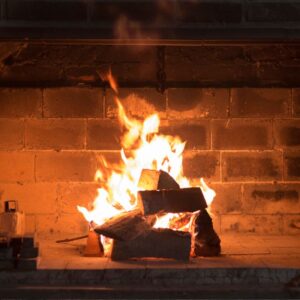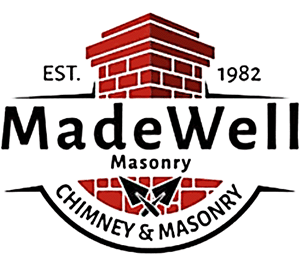As a chimney and masonry service company, we understand the importance of selecting the right materials for your masonry construction or repair projects. If you want your project to last, choosing the right materials is a solid first step.
Bricks are a time-tested, durable building material, but not all bricks are alike. Different types and classifications of bricks lend themselves to meeting different needs. What makes them so different? The main contributors to bricks’ differences are composition and drying method. These factors will contribute to their strength, texture, density, size, and overall aesthetic – and the ways you can make the best use of them.
Two types of brick that are especially relevant to anyone constructing an appliance that will involve high heat are common brick and firebrick. Both of these types of brick are very useful, but knowing where exactly to put each to work will maximize the safety, efficiency, and effectiveness of the finished product. And who doesn’t want that?
What Is Common Brick?
 Common brick, also known as building brick or red brick, is the brick you see most in homes. If you’ve seen a brick facade or wall in a home or business, it’s probably constructed of common brick. As its name suggests, it’s versatile and widely used.
Common brick, also known as building brick or red brick, is the brick you see most in homes. If you’ve seen a brick facade or wall in a home or business, it’s probably constructed of common brick. As its name suggests, it’s versatile and widely used.
Common brick has been a staple in the construction industries for centuries. It’s generally sub-divided into four classes, with fourth class bricks being the lowest quality and first class bricks the highest. Second class bricks are kiln-fired and strong, but inconsistent in shape and texture. Third class bricks are weaker and useful only in temporary structures or for decorative purposes, and fourth class bricks are unsuitable for building – they’re typically crushed, mixed with other components, and used as a construction aggregate. First class bricks, however, are prized for their strength and uniformity, making them excellent quality for building.
Some characteristics of common brick can be assessed in the following categories:
- Availability. Common brick is crafted from natural clay and shale, molded, and fired. Because clay is so ubiquitous in many parts of the world, common brick is a widely available and relatively affordable building material.
- Durability. Common brick exhibits good durability and high compressive strength, which makes it desirable for many uses, from walkways and fences to load bearing walls. However, its durability diminishes when exposed to frequent extreme changes in temperature.
- Heat resistance. Common brick can handle some moderate heat exposure, but it’s not designed to withstand intense temperatures such as those generated by a furnace, fireplace, or wood-burning stove. Sudden, extreme, or prolonged exposure to high heat will cause common brick to crack and deteriorate.
What Is Firebrick?
Firebrick is also called refractory brick or heat-resistant brick. It’s specifically engineered to withstand the extreme temperatures of fireplace and stove environments.
- Heat resistance. Composed of high-temperature refractory materials such as clay, alumina, and silica, firebrick can be exposed to intense heat produced during combustion without being compromised. Firebricks can not only withstand high heat, they can withstand a high degree of thermal shock, meaning quick transitions from cooler to hot temperatures won’t necessarily lead to breakdown.
- Insulating properties. Firebrick has superior insulation capabilities which help it retain heat within a fireplace, kiln, or stove. This is good news for the appliance owner, because it means optimal fuel efficiency and reduction of heat loss. This helps maintain consistent temperatures, enhance performance, minimize strain on the system, and protect other components.
- Durability. Heat-handling super powers aside, firebrick is highly durable in general, which helps ensure a long-lasting structure.
Importance of Firebrick in Fireplaces
 When it comes to constructing or repairing a chimney or similar structure, firebrick and common brick both have roles to play. Typically, the firebox – the area within your fireplace or stove that actually contains the fire you’ve built – is constructed from firebrick, while the rest of the chimney is primarily constructed from common brick or cement block, both of which are durable, yet less costly and dense than firebrick.
When it comes to constructing or repairing a chimney or similar structure, firebrick and common brick both have roles to play. Typically, the firebox – the area within your fireplace or stove that actually contains the fire you’ve built – is constructed from firebrick, while the rest of the chimney is primarily constructed from common brick or cement block, both of which are durable, yet less costly and dense than firebrick.
Using firebrick in your firebox protects the rest of the chimney system from shock due to high temperatures by acting as a barrier that protects masonry and other surrounding areas from heat-related damage. By strategically incorporating firebrick, you significantly reduce the risk of heat transfer,chimney fires and structural failures, and you also optimize system performance.
We Offer Professional Service From Experienced Techs
Selecting the appropriate materials for your chimney construction and repair is vital for its safety, performance, and longevity, as is proper installation. We hope you’ll trust our skilled, detail-oriented technicians at Madewell Masonry and Chimney for your next masonry project. We offer quality workmanship to meet all your chimney needs, whether you’re in need of an inspection, chimney sweeping, chimney relining, tuckpointing, or more.
We also prioritize keeping the customer’s concerns in mind, which is why we’re fully licensed and insured and offer fair, transparent pricing. Our strong values are the foundation of our business.
Call or reach out online today to get started working with us.

Recent Comments